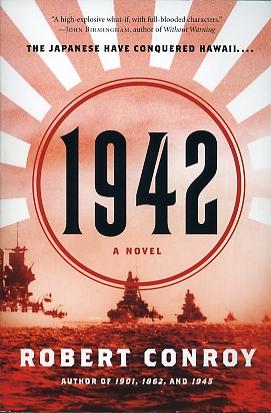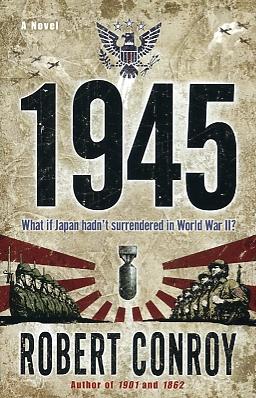The Battles of Hawaii and Japan
Alternative histories in present-day garb
By William Wetherall
First posted 5 May 2010
Last updated 7 May 2010
Robert Conroy 1942, 2009 Ethnic Relations 101
Robert Conroy, 1945, 2007 Nisei hero gets his girl

Ethnic Relations 101 (3 units)* Robert Conroy As a thriller, Robert Conroy's 1942, his fourth work of "alternate history", is passably good. As a "novel" long on in-your-face explanation and short on dramatic characterization, though, it fails. Conroy's characters are little more than plastic replicas of familiar cardboard cutouts. The plot is essentially a blend of wartime heroism and hero-gets-heroine romance. Japan attacks Pearl Harbor in the historically familiar manner. The alternative twist begins when some ambitious Japs decide they might as well invade, occupy, Japanize, and annex the Hawaiian Islands, from which to more easily take Alaska and bomb the Westcoast in order to force the United States into a quick, negotiated peace. A military and civilian resistance movement falls into place and builds on the islands as spontaneously as Japan's ad-hoc scheme unfolds. The military arm of the movement, lead by a US Army intelligence officer who had been stationed in Honolulu, takes refuge in the jungles on Hawaii, obsentively to keep a naval intelligence officer at a listening post from falling into enemy hands and possibly being forced to reveal that the United States had cracked Japan's diplomatic code, called Majic. In the meanwhile, the motley military unit on Hawaii is in touch with civilian resisters on Hawaii, Malau, and of course Ohau. And Doolittle, instead of leading Army B-17s off Navy carriers to bomb Tokyo and trying to land somewhere in China, is given the task of converting several giant flying boats to bombers capable of hitting Japanese carriers and replenished oil tanks at Pearl and then fly back to the westcoast. Conroy at times appears to be making ahistorical distinctions between good "Japanese" and "Japanese Americans" and bad "Japs". These and other prosaic gestures to gods born decades after the war are typical of stories contrived to meet today's multiculturalist marketing standards -- fine if one likes historical fiction in the guise of present-day social sensibilities. |

One-armed nisei hero from Hawaii gets his girl Robert Conroy 1945 is Conroy's third alternate history, the first two being 1901 and 1862. His fourth was 1942, an alternate history about Pearl Harbor and the Pacific War (see above). The front cover of the paperback edition, not the title page, declares 1945 "a novel". He wrote it before, but I read it after, 1942. Perhaps he'll now write a thriller called "1905", in which the United States helps Russia defeat Japan? The front cover also asks "What if Japan hadn't surrendered in World War II?" While intended to bait the reader, the statement is somewhat odd, for the story is really about how Japan did -- eventually -- surrender. Introduction and PostscriptConroy makes a few odd statements in the Introduction and Postcript, which are intended to be historical. IntroductionConroy states that "the militarists who ran the nation" regarded as mortal insults "any thoughts of making the powers of the emperor subject to the will of the people. After all, didn't the emperor own the people?" But no right thinking "militarist" in Japan would have thought that the emperor "owned" the people. Concerning peace, Conroy makes this remark (page ix).
Depending on what one means by "the Japanese peace movement" one could aruge that there were always people in Japan, including officials, who were seeking peace. Some feelers for peace had received some attention in Washington, though neutral states, long before the atomic bombs were dropped on Hiroshima and Nagasaki. Conroy remarks that "Additional atomic weapons would have been used against Japan" -- by which he means that "More atomic bombs would have been dropped on Japan" -- and "Cities such as Kokura and Niigata were already on the short list of targets, and more would have been added. The second bomb had been intended for Kokura, but clouds compelled the mission to continue to Nagasaki. In his story, Kokura becomes the third city to be destroyed by an atomic bomb. PostscriptConroy writes of Admiral Ozawa [Jisaburō] that "There is confusion about the exact year of his death" but Japanese news papers reported his death in 1966. Conroy writes that Commander Mochitsura Hashimoto later "disappeared and may have entered a monastery" and that "Like Hashimoto, [Lieutenant General [Shirō] Ishii's] ultimate fate is not known. But we know that both men died -- Hashimoto in 2000 and Ishii in 1959. SynopsisThe back cover of the paperback edition of 1945 gives the following synopsis.
Paced thrills and laughsThe formula for such stories is well understood. Multiple characters and venues allow scene and mood switching, which facilitate the turning of pages. Some of the dialog is contrived to educate the reader. Military commanders, while speaking to each other, do not explain jargon that all present would have shared. They do not intentionally paraphrase personal names and place names in order to clarify who and where they are talking about. HirohitoThings don't get off too well on the historical score. In the Prologue, Conroy puts these words into the mouth of the emperor, addressing the officer who has come to kidnap him.
Japan has more than "a few" islands. In fact it has "a few thousand" islands of various sizes. Okinawa, not to mention Iwojima and a few other islands, had long before the eve of the planned surrender announcement been invaded and occupied by the United States. When referring to the enemy, Hirohito and the high command at times would have spoke of the United States. More generally, though, they would have spoken simply of "the enemy" or "the Allied Military" or whatever. And when talking about the fate of Japan during the summer of 1945, but especially on the eve of the intended surrender, they would also have talked about not only the United States but also the Soviet Union, which had already launched its invasion of Karafuto, which had become a prefecture. Joseph GrewConroy's mouth for much of what the reader is told about "Japan" and "the Japanese" in Chapter 14, is Joseph Grew (1880-1965), the ambassador to Japan at the time the Pacific War began. In the course of his lecture before President Truman and some members of his cabinet and military command, Grew says this (pages 86-87).
Grew goes on to outline what he considers the racial motivation for Japan's imperial expansion and its consequences for Chinese, Koreans, and Okinawans, and places like Manchuria and the Philippines. And, of course, we learn all about "the code of Bushido". Daniel InouyeThe lessor sung but for this reason truer hero of the novel is Sgt. Joe Nomura, who had lost his arm with in combat with the 442nd Regimental Combat Team. To this extent at least, Nomura, from Hawaii, is modeled after Senator Daniel Inouye. The main "alternate history" plot of the novel revolves around Nomura's ability to embed himself in Japan as a one-armed Japanese Imperial Army veteran and radio information to his Office of Strategic Services handlers during the invasion of Kyushu. Nomura eventually assumes the identity of a kenpeitai officer who is able to get close to Hirohito because he can play chess. Nomura wins Hirohito's confidence -- to the point he is able to mediate Hirohito's willingness to allow a joint US Army-Navy commando operation to free him from his captors and remove him from Japan so he can regain his authority and bring about the surrender he had wanted. By then, Truman is reluctantly willing to accept a surrender under terms that are somewhat less than unconditional. Conroy has Nomura say this about himself when talking to the OSS agents who had come to the hospital to recruit him (page 55).
The OSS recruiters apologize and turn to leave. Joe sighs "I'll go." Both men blink, and Joe says this (page 56).
Nomura retracts a few other things he told the OSS men in a fit of anger. He does not, however, qualify what he had said about his father having "naturalized". Implicitly, Nomura's father migrated to Hawaii from Japan. He would not, at the time, have been able to naturalize, for United States federal courts would have considered him "ineligible to citizenship" because of his putative "Japanese" race. Not to spoil the ending, but Nomura gets his girl. Or, rather, a girl gets Nomura. USSR and PalestineBecause in Conroy's story the Allied War against Japan continued, there is no Occupation of the Interior of Japan, and no divided US-Soviet occupation of Korea, as Conroy calls the territory of Chosen. He had, therefore, to deal with the larger political and military situation in East and Northeast Asia in a way that makes certain military developments in his story plausible. He does this by altering the future of Japan-USSR relations in Manchuria and Korea after the breakdown in mid-August peacetalks. Another alternate history twist involves US-British relations in the development of a war in Palestine. LevityAs the battle scenes get gorier, Conroy begins to inject some humor into his story. By the last hundred pages, he begins to have fun, including this thought in the mind of Lt. Gen. Matthew Ridgeway while being briefed by OSS agents about Nomura's idea of rescuing Hirohito (page 322).
1945 was not exactly a "helluva bestseller" but it does not appear to have harmed Conroy's bottomline. |